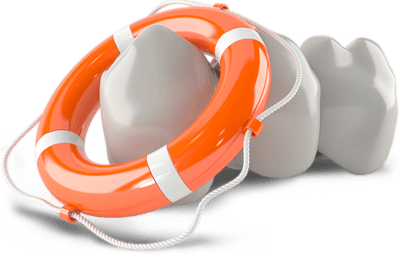When a tooth does not fully erupt into the mouth and remains either partially or completely hidden in the jaw bone or below the surface of the gum tissue, it is referred to as being “impacted.” Wisdom teeth are the most common teeth for which this happens. In the case of wisdom teeth that are impacted, they are usually extracted as leaving them in the jaw can lead to painful infections and other significant problems (see “Wisdom teeth” under Procedures).
The second most commonly impacted tooth is the maxillary canine (commonly referred to as the “eye” tooth). Canine teeth are critical teeth in the dental arch and play an important role in your “bite”. Canines are very strong biting teeth which have the longest roots of any tooth. They are often the first teeth that touch when your jaws close together so they can guide the rest of the teeth into the proper bite.
Normally, the maxillary canine teeth are the last of the front teeth to erupt into place. They usually come into place around age 13 and cause any space left between the upper front teeth to close tightly together. However, due to its very important role, if a canine tooth gets impacted every effort is made to get it to erupt into its proper position in the dental arch. The techniques involved to aid eruption can be applied to any impacted tooth in the upper or lower jaw but, most commonly, they are applied to the maxillary canine teeth. 60% of these impacted canine teeth are located on the palatal (roof of the mouth) side of the jaw. The remaining impacted eye teeth are found in the middle of the supporting bone but stuck in an elevated position above the roots of the adjacent teeth or facing out to the cheek/lip side of the dental arch.
When canine teeth are impacted and not aligned properly within the dental arch, an orthodontist will work closely with an oral surgeon to help get these teeth to erupt. Each case must be evaluated on an individual basis but treatment will usually involve a combined effort between the orthodontist and the oral surgeon. The most common scenario will call for the orthodontist to place braces on the teeth (at least the upper arch). Once in place, the braces will help shift the teeth around so a space can be created to provide room for the impacted tooth to be moved into its proper position in the dental arch. If the baby canine tooth has not fallen out already, it is usually left in place until the space for the adult canine tooth is ready. Once the space is ready, an orthodontist will refer the patient to an oral surgeon to have the impacted canine tooth exposed and bracketed.
In a simple surgical procedure performed in the surgeon’s office, the gum on top of the impacted tooth will be lifted up to expose the hidden tooth underneath. If there is a baby tooth present, it will be removed at the same time. Once the tooth is exposed, an oral surgeon will bond an orthodontic bracket to the exposed tooth. This bracket will have a miniature gold chain attached to it that will be temporarily attached to the orthodontic arch wire by an oral surgeon. In some cases, the surgeon will leave the exposed impacted tooth completely uncovered by suturing the gum up high above the tooth or making a window in the gum covering the tooth (in selected cases where the canine is located on the roof of the mouth). Most often, the gum will be returned to its original location and sutured back with only the chain remaining visible as it exits a small hole in the gum.
The patient will be ready to see their orthodontist again shortly after the surgery (1 to 14 days). A rubber band will be attached to the chain to put a light eruptive pulling force on the impacted tooth. This will begin the process of moving the tooth into its proper place in the dental arch. This is a carefully controlled, slow process that may take up to a full year to complete. If the tooth is moved through the jaw bone too quickly, it can unintentionally be extracted. Once the tooth is moved into the arch in its final position, the gum around it will be evaluated to make sure it is sufficiently strong and healthy to last for a lifetime of chewing and tooth brushing. In some circumstances, especially those where the tooth had to be moved a long distance, there may be some minor “gum surgery” required to add bulk to the gum tissue over the relocated tooth so it remains healthy during normal function. Any such surgery would be performed once the orthodontic care has been completed.













